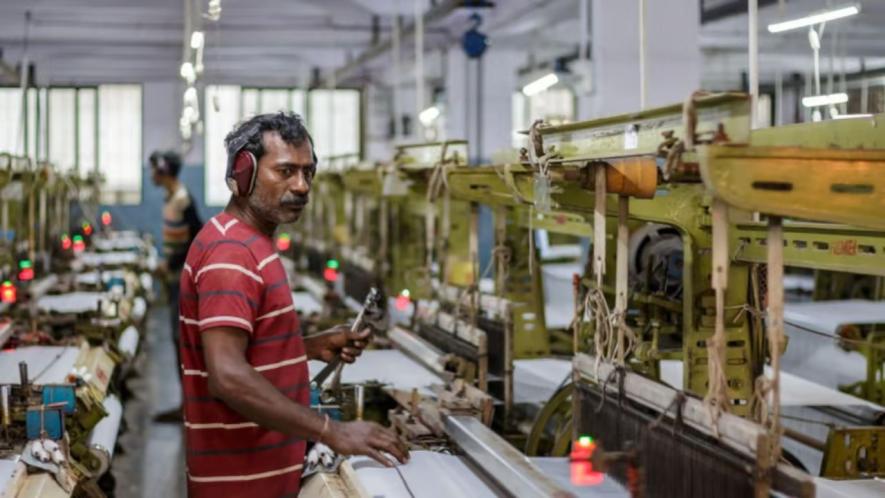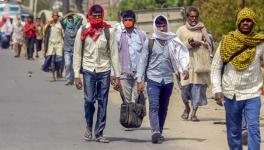Surat: Cost of a Billion-Dollar Textile Industry

Narendra* walks into a dingy room as we wait for his 15-year-old son to return from his second day at work.
“Just tomatoes for dinner today … with ₹2,500 rent and then electricity, my poor son has to look after me now. I am useless, I have told my wife to consider that her husband is dead. This month some [workers’] union friends lent me money and we managed to send ₹3,000 back home but how will I send money [regularly] now? I have told her to consider me dead, her son will look after everything now.”
A bespectacled Narendra visibly struggles as he walks towards his 3x4 metre room. With barely any space to stretch one’s legs, one corner of the room has a single stove burner and two kadhais while a small plastic bag of rice and six tomatoes sit in another corner. We enter the room ducking under the clothes hung above.
In July this year, a shuttle flew from a loom (sinchai) machine and hit him in the left eye. A spindle-shaped wooden device that carries the threads back and forth in the weaving process, the shuttle is an integral part of a traditional loom machine.
Any worker operating it will tell you how common it is for the shuttle to abruptly fly off the machine; sometimes breezing past a worker, sometimes hitting someone on the arm while in some ‘unlucky’ cases, it crashes into the eye of a worker at a speed of 120–130 kilometres per hour— as happened with Narendra.
I am useless, I have told my wife to consider that her husband is dead.
Narendra’s family of five, back in Ganjam, Odisha, heavily depended on the ₹20,000–25,000 that he earned in the textile sector. As the norm dictated, 20 years back, he remembers taking a half ticket (for minors) and travelling 1,500 km away to Gujarat where the majority of men from his district come for work.
The ‘better wages’ earned by migrants like him here come at the cost of continuous work, standing for 12 hours every day and with no paid leaves. In the backdrop of a 110–120 decibel working environment, a worker has gone from running three machines decades ago to now running 15–20 machines at once.
After 20 years of the same work, we have to shout a little for him to hear properly, and to that, he just laughs, “Tell me any loom worker who has good hearing.”
The piece-rate wage per metre of cloth produced has reduced over time. Currently, the wages are between ₹1.8 and ₹3 per metre, with the average production from a machine in a 12-hour shift being about 20–45 metres.
As the wages are based on production, workers continue taking up more work, disregarding safety or health to earn a decent wage. Interestingly though, the piece-wage is also dependent on the quality of cloth which is not in the control of a worker.
A few months ago, midway through his morning shift, when he was hit by a shuttle that flew off one of the machines, the employer immediately took him to the hospital. Later, he was shifted to an expensive private specialty hospital for ‘better services’, because at a government hospital, they would have to intimate the police and register a medico-legal case.
Unfortunately, after the treatment, he has lost almost all his vision in one eye and his other eye has been partially affected.
After 20 years of the same work, we have to shout a little for him to hear properly, and to that, he just laughs, “Tell me any loom worker who has good hearing.”
Even after working here for decades, often for years in the same unit, Narendra, like most workers, has zero proof of employment. It was only after the intervention of the union that a panchnama was done, whereby the employer informed the police about mysteriously losing the CCTV camera footage of that time and claimed the accident was due to the worker's own negligence.
The case was formally filed at the labour court. However, even before the first hearing, it was mutually settled for ₹2 lakh at the Lok Adalat held on September 14 this year.
Workers like Narendra settle for any amount as getting due compensation itself is a distant dream owing to the lack of knowledge and resources to pursue cases at a location of their choice. He is now ecstatic to go home, while his son, who dropped out of ninth standard after the news of the accident, has just entered the workforce for the first time picking up skills as a bobbin maker.
“Compared to the last time we talked, I am now a skilled worker, sister… My father should be less worried but I do not know when I will get to go home. (I hope) my siblings will at least continue their studies.”
Not every accident has the same fate. When Althaf* from Uttar Pradesh got his finger cut off in the machine, his employer paid him ₹1,000 and bore the cost of the medical treatment at a local clinic, while his dismembered finger lay below the machine for three days until he went again and removed it.
“Kya kare production rukna nahi chahiye!” (What to do, production should not stop). Althaf preferred going back to his native village rather than getting into legal trouble here. “Mujhe ye police mamle me nahi padhna, ye log sab bade log hai.” (I do not want to get involved in these police matters, these people are influential).
Who, what and how— The number game
Surat contributes 12 percent of the nation’s total fabric production and 28 percent of the nation’s total man-made fibre production. Thousands of big and small, registered and unregistered units are now established even on the outskirts of the city.
In 2018, the power-loom industry of Surat had an annual turnover of an astonishing ₹50,000 crore! Overwhelmingly toiling in this sector are single male migrants from Odisha, particularly from a single district, Ganjam.
During the past two years, in Surat alone, over 800 cases have been registered through the union and 60 cases filed in the labour court on issues of retrenchment, payment of wages, gratuity, accidents and deaths.
In fact, nearly one-third of the migrant workers from Ganjam’s Surada and Jagannathprasad work in Surat. It is estimated that at least seven lakh Odia migrants run the power looms here. No data is available on workers from Bihar, Uttar Pradesh and Maharashtra who are also part of the loom workforce.
Against this backdrop, Pravasi Shramik Suraksha Manch (PSSM) is probably the only union consisting solely of migrant loom workers in Surat amongst the hundreds of unions in the district. Formally registered in 2020, PSSM was incubated by Aajeevika Bureau, a labour rights organisation with a long-standing presence in precarious migration corridors of western India.
During the past two years, in Surat alone, over 800 cases have been registered through the union and 60 cases filed in the labour court on issues of retrenchment, payment of wages, gratuity, accidents and deaths.
Due to the general lack of evidence of work and the need for timely justice, out-of-court settlements through mediation is the most preferred avenue of justice.
“In my 25 years of work at Ved Road, Sayan and Navagam, I can guarantee you there is not a single unit that provides all workers with an identity card, notes our overtime work and reports accidents. These things have just become the norm of the industry,” says a key union member on condition of anonymity.
“When my previous employer discovered that we were part of this union, they circulated our photo in employer groups to prevent us from working anywhere so I am careful now.”
Occupational safety at a power loom
To understand the risks, it is important to understand what constitutes categories of work in a loom unit. A power loom establishment has different types of workers. Those who weave the raw yarn to make it stiff and durable. Those who individually take each thread and, using a warping machine, wrap it around an 80–120 kilogramme beam, which is carried by the workers themselves to be put on the loom machine. Those who actually run these machines to produce cloth.
A supervisor later measures the production and notes it down in a register kept with him in a different part of the unit. The machines, usually old and running continuously every day for 24 hours, require constant maintenance every day. This is done by another type of worker called the ‘master’. The unit usually has helpers and electricians and ancillary staff as needed.
From crush injuries, being sucked into and rolled in the machine, slip injuries carrying a beam of wrapped yarn through flights of stairs, to the shuttle flying off and hitting workers, electrocution or fire hazards— the possibilities of accidents at each step is manifold.
Between May to August 2024 alone, eight workers died due to electrocution while operating looms due to faulty wiring, improper insulation, lack of MCB/ELCB installations.
“In the last two months, there have been at least ten incidents of the shuttle flying out of the machines, once it grazed my arm too,” says a worker from the Limbayat area.
Between May to August 2024 alone, eight workers died due to electrocution while operating looms due to faulty wiring, improper insulation, lack of MCB/ELCB installations, etc. Given how frequently these accidents occur, it is astonishing how little attention this problem has received.
While a string of safety measures can be taken to minimise risks, it is a noteworthy observation by workers that the old loom machines are inherently risky. PSSM executive committee members inform us, “The rising death cases, especially in monsoons, led to us submitting a demand letter to the district collector, Surat in May this year. Subsequently, two workers died from electric shock.
“In August alone, we have reported five accidents. But the [Directorate of Industrial Safety and Health] DISH office informed us this is not in their ambit due to the units not being registered as factories.
“So then it begs the question, who is responsible and where should we go? It is a serious matter of concern.”
PSSM is yet to receive a response from the collector’s office on what actions or directives were given to the departments.
Working in Surat for over a decade, Aajeevika Bureau has also piloted a unique safety initiative with the loom owners in 2021. With part contribution from the organisation and largely from owners— a list of safety measures are adopted in an establishment terming it ‘Model Worksite’.
To date, 36 model worksites have been established across the district, where the workers have reported no shuttle injuries or electrocution post the installations, which range from general cleanliness and basic facilities to sensor light, re-wiring, insulation or MCB/ELCB.
Is it a big ask that businesses and administration fulfill the basic demand for a safe workplace?
Using these establishments as a ‘model’, advocacy efforts are strengthened with other units in the vicinity to adopt basic and often cost-effective safety measures.
In law, in practice— debating lives and limbs
Safety in a unit can range from cleaning oil spills to putting a ₹20 plastic cover on the lever of the machine. It is quite a wonder that even easily affordable small measures are also things workers struggle to demand and the owners casually wash their hands off the duty to provide.
The absolution of responsibility starts at the registration of the unit itself. Most power looms involved in the manufacturing process (clearly with the aid of power) are registered under the Gujarat Shops and Establishments Act, 2019 instead of the Factories Act, 1948. Thus, they fall under the monitoring responsibility of municipal corporations and, in some cases, gram panchayats.
Neither of these agencies have the capacity or even the inclination to inspect labour law violations. In practice, one owner may register a single unit as multiple ‘shops’ to further devolve taxation and labour compliances. This makes any non-wage costs of employment such as insurance virtually non-existent.
The amended definition in Gujarat provides that an “establishment” can mean a place that carries on a “business, trade, [or] manufacture”— manifestly in conflict with what constitutes a factory.
However, that makes these registrations per se legal— systematically allowing lesser standards of safety and welfare than what was envisaged in factories and putting them beyond the ambit of inspections of the nodal authority of safety in the state (DISH).
This was evident in a right-to-information (RTI) response by the DISH office (No. 0213/RTI/08/2024) in September 2024 stating that they keep records of fatal accidents only with regard to registered factories. Thus, even if reports of accidents in loom units are sent to them, they apparently have no power to intervene.
The monitoring of occupational safety and health of workers in shops and establishments is the responsibility of one gumasta officer or gram panchayats if the units are beyond city limits. They cannot properly ensure the occupational health and safety of lakhs of workers.
The first step towards raising labour law violations is establishing proof of a working relationship. Accessing formal legal systems or even relevant government departments becomes difficult for workers because they are not able to prove that they are employed in a particular unit.
Is it a big ask that businesses and administration fulfill the basic demand for a safe workplace? These concerns can only be brought to light when a designated authority monitors the safety standards accessible to workers to raise complaints.
The dilution of powers of inspection in the new labour codes will critically exacerbate these issues. Against this backdrop, the humongous wall of bureaucracy, exploitation and politics in front of a union such as PSSM may seem daunting.
However, nobody knows the situation better than the workers. The union has submitted a demand letter to the collector of Surat and the district shops and establishment authorities on the flagrant violations of labour laws regarding the implementation of formal payment of wages and identity cards for workers.
The former president of PSSM remarks, “We are already old and this fight may take five, ten or even 20 years but we will continue our demands for dignified working of loom workers and hope this forces somebody to listen to us.”
In a state that takes tremendous pride in development and industrialisation, the lives of migrant workers too require as much attention as small businesses, if not more.
*Names changed to avoid identification.
Get the latest reports & analysis with people's perspective on Protests, movements & deep analytical videos, discussions of the current affairs in your Telegram app. Subscribe to NewsClick's Telegram channel & get Real-Time updates on stories, as they get published on our website.
























